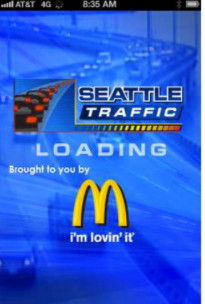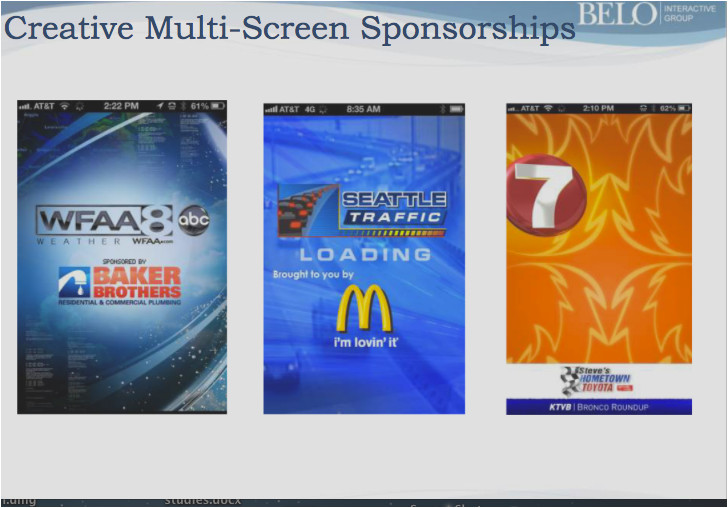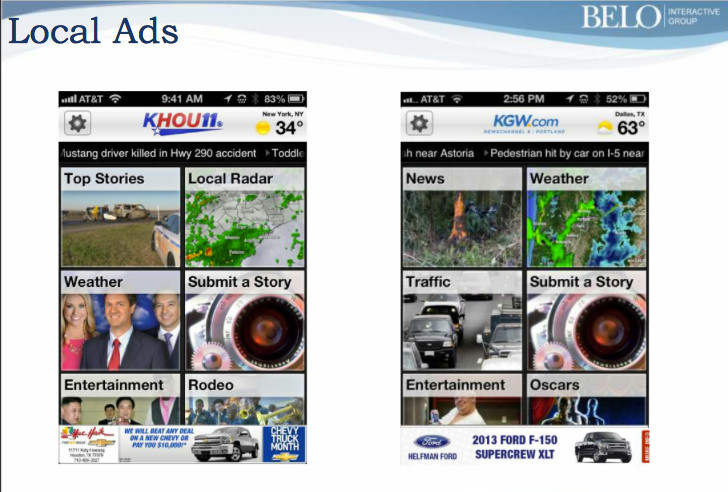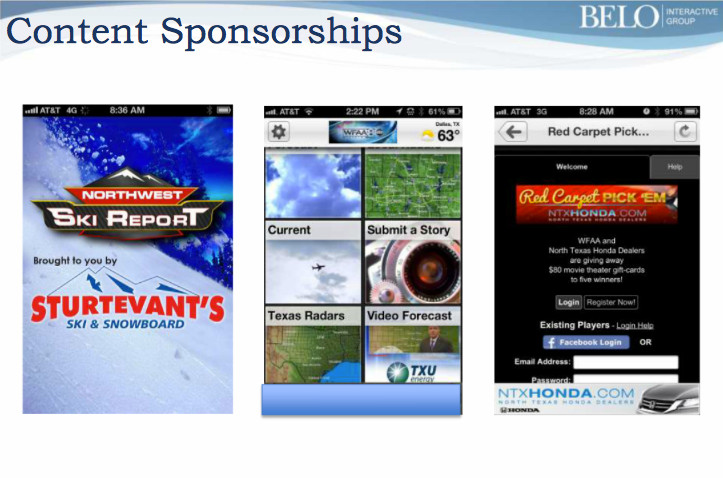How Belo Interactive makes multi-millions from mobile
Solid investment in simple formula
Editor's Note: Borrell & Associate's bubble chart on media sales of mobile shows most companies struggle to seek out small ammounts of mobile revenue - with a few notable stand-outs. Those companies, however generate millions from mobile sales programs that are in some cases only a year or two old. At the 2013 Local Advertising Conference, Borrell invited three top-performing companies including Belo Interactive to outline their strategy. This case study is taken from this presentation and follow-up interviews. While Belo is a larger local media group, the basic formula applies to other media companies in smaller markets with fewer development resources.
Company: Belo Interactive Group and Belo's 15 television markets
Markets: 15 television markets, all in the top 52 DMA's, with 7 in the top 25 DMA's, including Seattle, Dallas, Houston and New Orleans
Initiative: Developing and selling mobile audiences
Key executive: Joe Weir VP, Belo; David Karabag, Director of Product management
Challenge: Belo Interactive executives discussed the report released by Neilson that described the emerging multi-screen audiences: Multi-screen users outnumber single screen users by a ration of 2.5 to 1, and the largest group employ three screens. In fact there are almost as many three screen users as single screen TV watchers. Like many media companies, Belo's digital team saw the need to supply content on mobile devices, but needed to create a strategy that could result in significant revenues. The challenge was, in brief, how to create successful mobile products and monetize those new audiences.
Strategy
Belo Interactive created a “Mobile Lab” to help guide development strategy and partnered with top minds in the business to assist with development, team that followed a few basic premises in launching apps and selling mobile audiences:
1. Develop apps that take advantage of each station and market's core strengths.
2. Local markets drive the initiative, but a template approach across the network helps simplify the approvals and release process
3. Sales managers create packages that include big new audiences on apps, but sells the audience across platforms, not the app itself.
4. Sales focuses on a large accounts capable of spending six figures or close to it, especially accounts looking for new digital opportunities.
One of Weir's two key premises is to invest in apps that take advantage of market strengths and areas in which stations are market leaders such as weather or sports. "Your brand is what keeps you going," Karabag said. The other tenant is to focus sales and packaging to attract major accounts. "We try not to major in the minors."
Development team
Working to develop core and niche apps and moble sites across 15 markets for a total of 70 apps, Belo Interactive created a corporate team to lead strategies and innovation and partnerships but the drivers are the local market experts that make up Belo’s Mobile Lab.
The corporate team has a Director of Product Development with two reports: A Mobile coordinator to help administrate apps through the cumbersome approval process plus analytics and metrics, and a manager of emerging products.
A key development strategy is keeping decisions on types of mobile apps "in market", allowing them to experiment and share information autonomously at weekly meetings that are not run by corporate but by the network of mobile experts and provide feedback and a/b testing between markets.
"Conversations that happen locally are brought out to the overall network. Allows us to scale much more quickly... They can a/b test in different markets." Karabag said.
A "Recommendations lab" was created to give more formal overall feedback on efforts that were not doing as well. "The group gets together and looks at key words and screen shots and puts together a recommendation to present to the market."
Still the apps are built and templated by a third party developer. "We could not approach 70 differenct niche app and 15 core apps, without a templated approach and scalability. It's up to local markets to drive strategies, while corporate team develops the technology and partnerships," Weir said.
Products
After all that testing, what apps are most popular - and responsible for millions in new revenues?
Each station has a basic app for news, and all apps use push notifications because because they are effective at driving traffic into the app and "it's free" compared to the costs of SMS.
Rather, each market prioritizes the best franchises. The top four apps launched across almost all markets are weather, sports, events and traffic. Events is typically the smallest app, weather is seasonal, and sports is only launched in markets with huge fan bases. Most stations - that is 11 or 12 - have at least weather and traffic.
"The emphasis in each market was driven by the audience demand," Karabag said.
Since St. Louis is is a big sports city, the local station KMOV TV branded its app as BaseballSTL. During the season the app has millions of pageviews per month, with push notification of events, scores, home runs and trivia. The peek usage is when the games are in play. Similarly, a Boise, Idaho station launched Bronco Round Up for the local university.
The biggest upcoming star among the apps, however, may be a weather app WeatherCaster launched in September 2012 for the iPad. The app, which won the 2012 Tabby Award and has a 4.5 star rating in the app store, took seven to eight months of development in cycles of monthly releases and is releasing for the SmartPhone in April 2013.
"We built it in consultation with eight of our top meterologists who are local market leaders. The key is geo-location, getting the local video and forecast." As the network of local weather apps builds, people are able to access weather where ever they are. For some stations such as WFAA in Dallas, which already owned the largest share for weather in its on-air program, the weather app has become huge.
"WFAA is number one for weather in Dallas," Karabag said.
Niche apps such as a ski report have been also been launched. A few apps did not work – four or five were dropped at the beginning of 2013, including a “cutesy” app to track sitings of Chupacabras, a mysterious small animal rumored to live in the San Antonio area. Failures are typically “not useful” or “don’t have a promotional plan behind it.”
“If you don't have a way of telling people here’s what we have to offer, they are not going to find it, and you are not going to get the traffic you need.”
Sales
True to the mantra, “Don’t major in the minors,” the team looks for major sponsors able to spend six figures or close to it on the digital portion of the campaign, as incremental dollars. Mobile is packaged with onair and online display, as an important new audience.
“These are multi-screen sponsorships. We go across all of the platforms. You are not buying an app, you are buying an audience.”
Here are a few examples of mega-sales that taken together account for miillion in new, incremental digital revenues:
•Mobility and day-parting attract McDonald's. The traffic app for Seattle and Portland became integral to selling a digital campaign to McDonald’s Café program. McDonald's aimed to compete with Starbucks in its own backyard. To reach people on their way to work, the campaign day-parts the morning drive.
“The last thing they do before they start the car is check the traffic app, where they see the café ads to stop in and get your coffee.” The app also allows users to locate a McDonald's near them from their phones.
•Monetizing app launch promotions for large branding campaigns. WFAA’s huge weather app was a draw for one of the station’s major advertisers, Baker Brothers' Plumbing. Already a market share leader, Baker wanted to extend its brand awareness to increase direct calls and improve search conversions. The Dallas market, however, is enormous geographically and otherwise, so adding mobile audiences to an onair buy created a win/win.
“The nice thing is that you can take the money and put it towards the overall app promotion. Then we can snag the big dollars" Karabag says. in addition to display ads on the apps, every time the app was mentionned onair, anchors noted it was 'brought to you by Baker Brothers." The campaign was so successful, that company re-upped in 2013.
• Using interactivity to sell auto dealers. The automotive category has been unusually enthusiastic about including mobile audiences in its buys. The most common strategies include competitive branding and enticing visitors to clicking back into the inventory.
Many dealers will buy the mobile banner ads on the second week of month. The creative typically has an incentive, such as a financing offer, to take the customer into the site to see the inventory. Karabag advises not to point ads at the main web site but rather directly to search the inventory.
“If you are advertising, say, 2.9 percent finannicing on Honda Accords (the landing page should point) to the Honda Accords.”
• Selling niche apps to the logical co-brand. In addition to auto and home improvement, niche sites such as the ski report are easily sponsored by a local ski store.
Results
• Companywide Belo interactive boasts hundreds of millions page views across 70 apps in its 15 markets.
• Most digital sales that include apps are six figures or close to it. Mobile revenues are now 1% of total sales. "It's multi-millions for us."
• Revenue growth is triple digits year over year and month to month.
Lessons learned
• While most local media struggle to sell mobile, a few are seling millions per year.
• "As you see consumer adoption, so goes the revenue." The key to the difference in results in this case is the formula, not the medium.
• iPads and iPhones are considered the combined mobile audience, added to desktop and sold as the total interactive audience, to generate higher incremental dollars.
• Large companies who invest in ongoing app development and competitive dominance in core franchises are already commanding high dollars and securing mobile franchises.
• Build apps where your media is number one in the market. "Your brand is what keeps you going" and allows companies to promote their app to people already getting that type of information from the media.
• Combining semi-automous local strategies and corporate development resources is a successful formula. Belo uses coprorate to set priorities, develop and template the apps and negotiate the app store. A team of local mobile experts develops and vets strategy.
• Sell the total interactive audience across platforms.
• Take advantage of interactive features such as the ability to entice user to click on an offer to view inventory, day-parting and or to find nearby locations.
• Apps created need to be useful enough for consumers to make an effort to download them and have a promotional plan.
• Core apps for television sites are weather, traffic, sports and events, with events being the smallest. Core advertisers are often existing major accounts looking for new digital opportunities.
• Have a promotional plan that integrates launch promos into legacy content. Find a launch partner who will pay top dollar to participate in - and thus monetize - the launch promotions.
• Ultimately, app popularity is a key to attracting six figure sales. However, the size of the audience required varies by market. While Dallas might require a million views to provide the definitive sizzle, the market for Boise is different.
• Go after big accounts and package accordingly. "Try not to major in the minors." Selling small numbers of impressions is not best practice for mobile, as it is not in online display.
Many thanks to Joe Weir VP, and David Karabag, Director of Product management , Belo Interactive for sharing their success story and the strategic thinking behind it. Also to Borrel & Associates' Local Interactive Advertising Conference for hi-lighting successes across the industry spectrum.

The author, Alisa Cromer is publisher of a variety of online media, including LocalMediaInsider and MediaExecsTech, developed while on a fellowship with the Reynolds Journalism Institute and which has evolved into a leading marketing company for media technology start-ups. In 2017 she founded Worldstir.com, an online magazine, to showcases perspectives from around the world on new topic each month, translated from and to the top five languages in the world.













